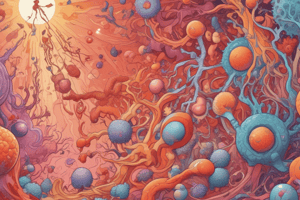Podcast
Questions and Answers
What is the primary function of innate immunity?
What is the primary function of innate immunity?
- To provide long-term immunity against pathogens
- To produce cytokines for immune response
- To act as a specific immune response to pathogens
- To serve as the first line of defense against infection (correct)
What is the characteristic of chronic inflammation?
What is the characteristic of chronic inflammation?
- Immune system attacks healthy cells and tissues
- Long-term, low-grade inflammation (correct)
- Increased blood flow, swelling, heat, redness, and pain
- Rapid, short-term response to injury or infection
What is the result of an overactive immune response to harmless substances?
What is the result of an overactive immune response to harmless substances?
- Hypersensitivity reactions (correct)
- Immunodeficiency
- Autoimmune disorders
- Inflammation
What is the target of HIV infection in the immune system?
What is the target of HIV infection in the immune system?
What is the characteristic of AIDS?
What is the characteristic of AIDS?
What is the result of HIV integration into host DNA?
What is the result of HIV integration into host DNA?
What is the effect of HIV on CD4+ T-cells?
What is the effect of HIV on CD4+ T-cells?
What is the result of HIV disruption of immune cell function?
What is the result of HIV disruption of immune cell function?
Flashcards are hidden until you start studying
Study Notes
Immune Response
- Innate Immunity:
- First line of defense against infection
- Includes physical barriers (skin, mucous membranes), phagocytic cells (neutrophils, macrophages), and antimicrobial peptides
- Adaptive Immunity:
- Specific immune response to pathogens
- Involves activation of T-cells and B-cells
- Memory cells provide long-term immunity
Inflammation Types
- Acute Inflammation:
- Rapid, short-term response to injury or infection
- Characterized by increased blood flow, swelling, heat, redness, and pain
- Chronic Inflammation:
- Long-term, low-grade inflammation
- Can lead to tissue damage and disease (e.g., arthritis, atherosclerosis)
Immune System Disorders
- Immunodeficiency:
- Weakened immune system, making the body more susceptible to infection
- Examples: Severe Combined Immunodeficiency (SCID), HIV/AIDS
- Autoimmune Disorders:
- Immune system attacks healthy cells and tissues
- Examples: Rheumatoid Arthritis, Lupus, Type 1 Diabetes
- Hypersensitivity Reactions:
- Overactive immune response to harmless substances (e.g., allergies)
AIDS Pathophysiology
- HIV Infection:
- Human Immunodeficiency Virus (HIV) targets and destroys CD4+ T-cells (helper T-cells)
- Weakens immune system, making the body vulnerable to opportunistic infections
- AIDS (Acquired Immunodeficiency Syndrome):
- Advanced stage of HIV infection, characterized by severe immunodeficiency and opportunistic infections
- Diagnosed when CD4+ T-cell count falls below 200 cells/μL or with the presence of certain opportunistic infections
HIV Pathogenesis
- Viral Replication:
- HIV integrates into host DNA, allowing it to replicate and produce new viral particles
- Viral load increases, leading to immune system decline
- CD4+ T-Cell Depletion:
- HIV targets and destroys CD4+ T-cells, impairing immune function
- Decreased CD4+ T-cell count indicates disease progression
- Immune System Dysfunction:
- HIV disrupts immune cell function, leading to impaired cytokine production and immune response
- Increased susceptibility to opportunistic infections and cancers
Immune Response
- Innate immunity is the first line of defense against infection, involving physical barriers, phagocytic cells, and antimicrobial peptides.
- Adaptive immunity is a specific response to pathogens, involving T-cells and B-cells, and provides long-term immunity through memory cells.
Inflammation
- Acute inflammation is a rapid, short-term response to injury or infection, characterized by increased blood flow, swelling, heat, redness, and pain.
- Chronic inflammation is a long-term, low-grade response that can lead to tissue damage and disease.
Immune System Disorders
- Immunodeficiency is a weakened immune system, making the body more susceptible to infection, with examples including Severe Combined Immunodeficiency (SCID) and HIV/AIDS.
- Autoimmune disorders occur when the immune system attacks healthy cells and tissues, with examples including Rheumatoid Arthritis, Lupus, and Type 1 Diabetes.
- Hypersensitivity reactions are an overactive immune response to harmless substances, such as allergies.
AIDS Pathophysiology
- HIV infects and destroys CD4+ T-cells (helper T-cells), weakening the immune system and making the body vulnerable to opportunistic infections.
- AIDS is the advanced stage of HIV infection, characterized by severe immunodeficiency and opportunistic infections, diagnosed when CD4+ T-cell count falls below 200 cells/μL or with the presence of certain opportunistic infections.
HIV Pathogenesis
- HIV replicates by integrating into host DNA, allowing it to produce new viral particles, leading to an increase in viral load and decline of the immune system.
- HIV targets and destroys CD4+ T-cells, impairing immune function and depleting CD4+ T-cell count, indicating disease progression.
- HIV disrupts immune cell function, impairing cytokine production and immune response, leading to increased susceptibility to opportunistic infections and cancers.
Studying That Suits You
Use AI to generate personalized quizzes and flashcards to suit your learning preferences.




